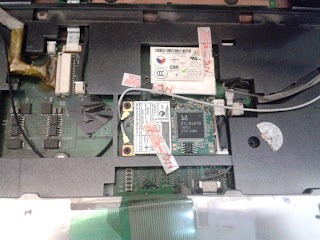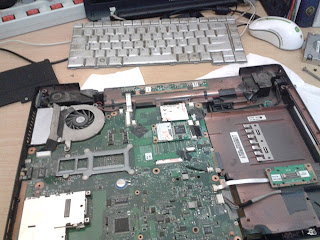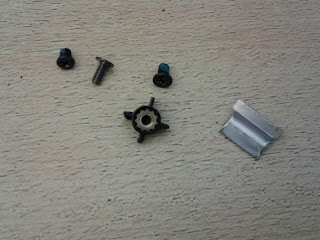Kali ini adalah kali kedua saya membongkar laptop. Pertama kali membongkar laptop karena penasaran kenapa laptop saya begitu panas. Akhirnya didapati bahwa ada debu yang begitu tebal di sekitar kipas CPU.
Namun yang kedua ini alasannya berbeda. Berawal dari penunjukan saya sebagai salah satu asisten kuliah oleh seorang dosen, saya kemudian merenung apa saja yang perlu dipersiapkan. Saya teringat bahwa port VGA laptop saya bermasalah (seperti ada yang mengganjal di dalam lubangnya). Saya tidak mengecek bagian mana yang rusak namun entah kenapa saya langsung berasumsi bahwa port VGA nya mungkin harus diganti.
Pertama lepas harddisk, RAM, dan DVD Drive
Lanjut melepas casing terluar
Tidak lupa mengambil gambar letak kabel-kabel untuk mencegah kesalahan memasang kembali karena lupa.
Lepas monitor
Lepas kabel mouse pad
Yak, periferal sudah terlepas, tampak lah mainboard-nya.
Setelah melepas kipas dan CPU kelihatanlah debu di sekitar saluran udaranya.
Ini dia port VGA
Saya mulai dengan memasukkan kawat ke lubang pin yang normal dan ke lubang yang bermasalah. Lalu saya bandingkan perbedaanya. Terasa lubang pin yang bermasalah (pin 11 - pin 15) seperti ada yang menyumbat. Pin-pin 12 - 15 adalah pin-pin yang penting. Pin 12 untuk I2C data, pin 13 horizontal sync, pin 14 vertical sync, dan pin 15 I2C clock. Saya sempat bingung bagaimana cara membersihkan lubang pin yang sangat kecil itu. Saya pun teringat bahwa saya punya mata bor yang cukup kecil yang dulu kala sering saya gunakan untuk mengebor PCB.
Penyumbatnya adalah serpihan plastik port VGA sendiri yang mungkin terkelupas karena mencolokkan port male (jarum) VGA kabel monitor yang posisi pinnya sudah sedikit bergeser sehingga menggerus plastik port female (lubang) VGA laptop saya.
Setelah selesai membersihkan port VGA saya memasang kembali laptop. Tetapi pada akhir didapati 3 baut belum terpasang, 1 buah plat yang saya tidak tahu dari mana, dan 1 buah dudukan baut yang patah. -_-
Tapi saya rasa tidak terlalu bermasalah. Kalo gitu mari kita coba nyalakan. B)
Jika dipikir-pikir keputusan saya untuk membongkar laptop adalah berlebihan. Seharusnya saya periksa terlebih dulu port VGA dari luar. -_-. Tapi tidak apa-apa, setelah dibongkar suhu laptop kembali menjadi tidak terlalu panas karena saya jadi bisa membersihkan debu pada kipas. :)
Oh iya, tak terasa laptop kesayangan ini sudah lima tahun menemani. :)). Sempat terpikir untuk membeli laptop baru saja. Laptop ini sudah tidak ada baterai dan ukurannya cukup besar. Tetapi karena sejauh ini pekerjaan saya yang kebanyakan hanya membuat aplikasi desktop atau web masih sanggup ditangani laptop ini dan belum perlu untuk hal yang berat seperti pengolahan grafis serta saat bekerja tidak sering berpindah-pindah jadi ditunda dulu untuk membeli yang baru. Supaya ngga mubazir, laptop disesuaikan dengan skill dan kebutuhan. Hehe.

.jpg)
.jpg)
.jpg)












Comments
Post a Comment